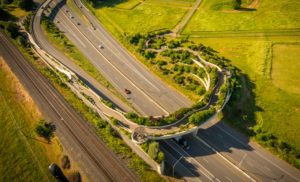Recognizing Our Shared Past to Improve Our Shared Future
The Confluence Project Shifts the Narrative Around the Columbia River
Just a few hundred yards from Columbia Land Trust’s main office at Fort Vancouver lies the Confluence Land Bridge, where art, nature, and infrastructure combine to celebrate the Indigenous people who have stewarded this land since time immemorial. Lined with native plants and basalt columns carved with indigenous artwork, the 40-foot-wide pedestrian bridge arcs over Washington State Route 14, connecting the historic fort with the north bank of the Columbia River. The Welcome Gate by artist Lillian Pitt (Wasco, Yakima, Warm Springs) greets visitors.
The Land Bridge is one of five completed art installations by the Confluence Project, a nonprofit working to connect people to the history, living cultures, and ecology of the Columbia River system through Indigenous voices. Founded by the late Jane Jacobsen, an active member of the Vancouver community and founding member of Columbia Land Trust, Confluence was created with the goal of shifting the narrative surrounding the Columbia River to one that centers the voices of the native people, rather than the voices of European explorers.
Since becoming Executive Director in 2014, Colin Fogarty has led the organization to develop meaningful tribal partnerships and find creative ways to connect people to place through art and education. In addition to art installations like the Land Bridge, Confluence offers youth education and professional development programs for teachers in local schools, and community programs like storytelling events and educational road trips. The organization has even compiled a digital library of interviews with more than forty Indigenous Elders and leaders from Columbia River tribes, preserving their important stories.
Confluence collaborates with tribal partners to create opportunities to explore the deep, interconnected relationship between people and nature. “Each one of our programs is a starting point on a journey to a more inclusive understanding of where we’re all from,” said Fogarty. “That journey begins with recognizing our shared history and our shared future.”
For example, Fort Vancouver sits atop a prairie where Indigenous people used fire to cultivate Camas, a traditional food prized for its edible root. “Part of the point of Confluence is listening to and learning from Indigenous people who have taken care of this landscape for 16,000 years and done it well,” said Fogarty. “It’s a reciprocal relationship—the land takes care of us and we must take care of the land.”
